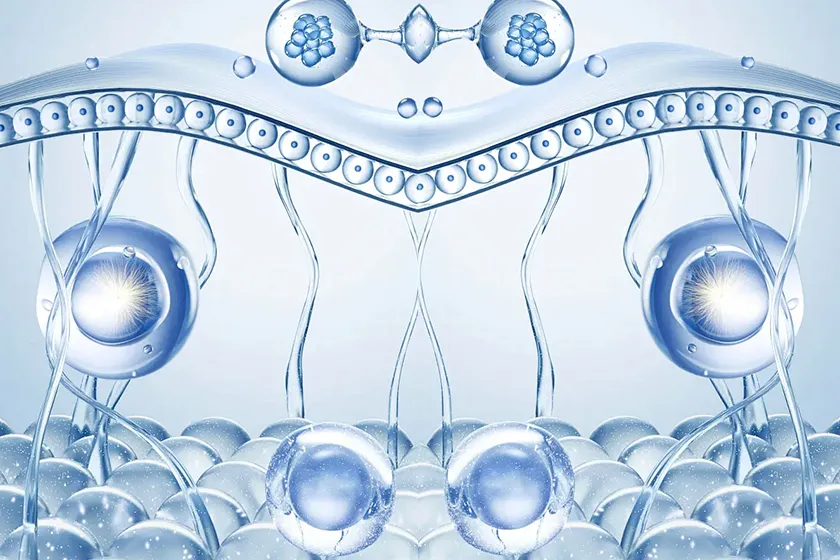Search
Breakthrough in Electrospinning Technology Eggshell Nanoparticle Composite Dressing Accelerates Wound Healing
A recent study published in Advanced Healthcare Materials introduces an innovative approach that transforms discarded eggshells into multifunctional nanofiber wound dressings using electrospinning technology. These dressings demonstrate rapid hemostasis, antibacterial and anti-inflammatory properties, and promote angiogenesis—collectively accelerating wound healing efficiency. This article explores the preparation process, functional validation, and clinical potential of this breakthrough.
1. Research Background Challenges in Wound Healing
The skin, the body’s largest organ, plays a critical role in protection, sensation, and temperature regulation. However, large wounds, chronic ulcers, and infections often delay healing and can even lead to tissue necrosis. Traditional dressings such as gauze and hydrogels offer only basic coverage, lacking multifunctional properties required for complex wound environments.
Innovation Highlights
Material Innovation: Eggshells (96.4% calcium carbonate with trace elements like Mg and Si) converted into bioactive nanoparticles (ECa NPs).
Enhanced Functions: Modified with tannic acid (TA) and strontium ions (Sr²⁺) to provide antibacterial, anti-inflammatory, and angiogenic effects.
Core Technology: Electrospinning integrates modified nanoparticles into polylactic acid/gelatin (PLA/Gel) fibers, producing stable and biodegradable dressings (PG-ETS).
2. Fabrication and Characterization Electrospun Biomimetic Scaffolds
Preparation of Eggshell Nanoparticles
Process: Eggshells calcined at 1000°C, ground into ECa NPs, then reacted with TA and SrCl₂ to form ECa-TA-Sr NPs.
Key Data: Particle size <10 μm with uniform Sr element distribution.
Electrospinning Parameters
Solution: PLA/Gel at 7:3 (w/w) ratio with 1 mg/mL ECa-TA-Sr NPs.
Conditions: Voltage 12 kV, flow rate 1.5 mL/h, fiber diameter ~0.72 μm.
Advantages:
Porosity (0.8–3.2 μm) mimics extracellular matrix (ECM), supporting cell migration.
Hydrophilicity: Contact angle 33.1°, better than pure PLA (49.9°), enhancing fluid absorption.
3. Functional Validation From In Vitro to In Vivo
Rapid Hemostasis
In vitro: Blood coagulation index (BCI) at 4.18% vs 56.2% in controls.
In vivo (rat liver model): Hemostasis achieved in 21 seconds, 2.7x faster than gauze.
Mechanism: Ca²⁺ activates coagulation pathways, TA promotes platelet aggregation.
Broad-Spectrum Antibacterial and Anti-Inflammatory Effects
Antibacterial: >80% killing rate against E. coli and S. aureus.
Anti-inflammatory: Inflammatory cells significantly reduced (21 vs 193/HPF in controls).
Angiogenesis and Tissue Regeneration
Angiogenesis: HUVEC cells formed vascular networks 3.2x higher than control.
Wound Healing: Rat full-thickness skin model showed 95.8% closure in 14 days with minimal scarring.
4. Advantages and Future Perspectives
Sustainability and Scalability
Eggshells are abundant, low-cost food industry byproducts.
Electrospinning is a scalable, mature manufacturing process.
Clinical Applications
Chronic wounds: Diabetic foot ulcers requiring infection control and angiogenesis.
Acute trauma: Emergency and battlefield hemostasis.
Burn treatment: Enhanced collagen alignment reduces scar formation.
Conclusion
The eggshell nanoparticle composite wound dressing demonstrates a sustainable and clinically valuable solution to wound care. With multifunctional properties—hemostasis, antibacterial action, anti-inflammation, and angiogenesis—this electrospun scaffold offers a next-generation strategy for managing both chronic and acute wounds. Its combination of biocompatibility, cost-efficiency, and high therapeutic efficacy positions it as a strong candidate for future clinical translation.

A recent study published in Advanced Healthcare Materials introduces an innovative approach that transforms discarded eggshells into multifunctional nanofiber wound dressings using electrospinning technology. These dressings demonstrate rapid hemostasis, antibacterial and anti-inflammatory properties, and promote angiogenesis—collectively accelerating wound healing efficiency. This article explores the preparation process, functional validation, and clinical potential of this breakthrough.
1. Research Background Challenges in Wound Healing
The skin, the body’s largest organ, plays a critical role in protection, sensation, and temperature regulation. However, large wounds, chronic ulcers, and infections often delay healing and can even lead to tissue necrosis. Traditional dressings such as gauze and hydrogels offer only basic coverage, lacking multifunctional properties required for complex wound environments.
Innovation Highlights
Material Innovation: Eggshells (96.4% calcium carbonate with trace elements like Mg and Si) converted into bioactive nanoparticles (ECa NPs).
Enhanced Functions: Modified with tannic acid (TA) and strontium ions (Sr²⁺) to provide antibacterial, anti-inflammatory, and angiogenic effects.
Core Technology: Electrospinning integrates modified nanoparticles into polylactic acid/gelatin (PLA/Gel) fibers, producing stable and biodegradable dressings (PG-ETS).
2. Fabrication and Characterization Electrospun Biomimetic Scaffolds
Preparation of Eggshell Nanoparticles
Process: Eggshells calcined at 1000°C, ground into ECa NPs, then reacted with TA and SrCl₂ to form ECa-TA-Sr NPs.
Key Data: Particle size <10 μm with uniform Sr element distribution.
Electrospinning Parameters
Solution: PLA/Gel at 7:3 (w/w) ratio with 1 mg/mL ECa-TA-Sr NPs.
Conditions: Voltage 12 kV, flow rate 1.5 mL/h, fiber diameter ~0.72 μm.
Advantages:
Porosity (0.8–3.2 μm) mimics extracellular matrix (ECM), supporting cell migration.
Hydrophilicity: Contact angle 33.1°, better than pure PLA (49.9°), enhancing fluid absorption.
3. Functional Validation From In Vitro to In Vivo
Rapid Hemostasis
In vitro: Blood coagulation index (BCI) at 4.18% vs 56.2% in controls.
In vivo (rat liver model): Hemostasis achieved in 21 seconds, 2.7x faster than gauze.
Mechanism: Ca²⁺ activates coagulation pathways, TA promotes platelet aggregation.
Broad-Spectrum Antibacterial and Anti-Inflammatory Effects
Antibacterial: >80% killing rate against E. coli and S. aureus.
Anti-inflammatory: Inflammatory cells significantly reduced (21 vs 193/HPF in controls).
Angiogenesis and Tissue Regeneration
Angiogenesis: HUVEC cells formed vascular networks 3.2x higher than control.
Wound Healing: Rat full-thickness skin model showed 95.8% closure in 14 days with minimal scarring.
4. Advantages and Future Perspectives
Sustainability and Scalability
Eggshells are abundant, low-cost food industry byproducts.
Electrospinning is a scalable, mature manufacturing process.
Clinical Applications
Chronic wounds: Diabetic foot ulcers requiring infection control and angiogenesis.
Acute trauma: Emergency and battlefield hemostasis.
Burn treatment: Enhanced collagen alignment reduces scar formation.
Conclusion
The eggshell nanoparticle composite wound dressing demonstrates a sustainable and clinically valuable solution to wound care. With multifunctional properties—hemostasis, antibacterial action, anti-inflammation, and angiogenesis—this electrospun scaffold offers a next-generation strategy for managing both chronic and acute wounds. Its combination of biocompatibility, cost-efficiency, and high therapeutic efficacy positions it as a strong candidate for future clinical translation.

Category
Recent Posts
